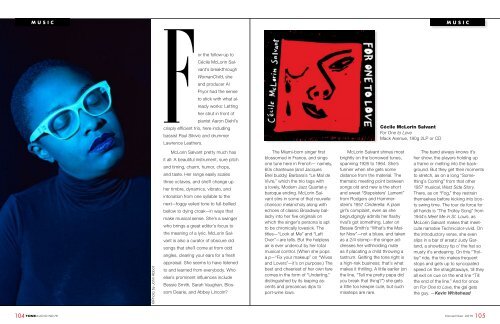You also want an ePaper? Increase the reach of your titles
YUMPU automatically turns print PDFs into web optimized ePapers that Google loves.
MUSIC<br />
MUSIC<br />
For <strong>the</strong> follow-up to<br />
Cécile McLorin Salvant’s<br />
breakthrough<br />
WomanChild, she<br />
and producer Al<br />
Pryor had <strong>the</strong> sense<br />
to stick with what already<br />
works: Letting<br />
her strut in front of<br />
pianist Aaron Diehl’s<br />
crisply efficient trio, here including<br />
bassist Paul Sikivic and drummer<br />
Lawrence Lea<strong>the</strong>rs.<br />
Cécile McLorin Salvant<br />
For One to Love<br />
Mack Avenue, 180g 2LP or CD<br />
©Photo by John Abbot<br />
McLorin Salvant pretty much has<br />
it all: A beautiful instrument, sure pitch<br />
and timing, charm, humor, chops,<br />
and taste. Her range easily scales<br />
three octaves, and she’ll change up<br />
her timbre, dynamics, vibrato, and<br />
intonation from one syllable to <strong>the</strong><br />
next—foggy veiled tone to full-bellied<br />
bellow to dying croak—in ways that<br />
make musical sense. She’s a swinger<br />
who brings a great editor’s focus to<br />
<strong>the</strong> meaning of a lyric. McLorin Salvant<br />
is also a curator of obscure old<br />
songs that she’ll come at from odd<br />
angles, clearing your ears for a fresh<br />
appraisal. She seems to have listened<br />
to and learned from everybody. Who<br />
else’s prominent influences include<br />
Bessie Smith, Sarah Vaughan, Blossom<br />
Dearie, and Abbey Lincoln?<br />
The Miami-born singer first<br />
blossomed in France, and sings<br />
one tune here in French— namely,<br />
60s chanteuse (and Jacques<br />
Brel buddy) Barbara’s “Le Mal de<br />
Vivre,” which <strong>the</strong> trio tags with<br />
a lovely, Modern Jazz Quartet-y<br />
baroque ending. McLorin Salvant<br />
stirs in some of that nouvelle<br />
chanson melancholy along with<br />
echoes of classic Broadway balladry<br />
into her five originals on<br />
which <strong>the</strong> singer’s persona is apt<br />
to be chronically lovesick. The<br />
titles—“Look at Me” and “Left<br />
Over”—are tells. But <strong>the</strong> helpless<br />
air is ever undercut by her total<br />
musical control. (When she pops<br />
a p—“Fix your makeup” on “Wives<br />
and Lovers”—it’s on purpose.) The<br />
best and cheeriest of her own fare<br />
comes in <strong>the</strong> form of “Underling,”<br />
distinguished by its leaping ascents<br />
and precarious dips to<br />
port-wine lows.<br />
McLorin Salvant shines most<br />
brightly on <strong>the</strong> borrowed tunes,<br />
spanning 1926 to 1964. She’s<br />
funnier when she gets some<br />
distance from <strong>the</strong> material. The<br />
<strong>the</strong>matic meeting point between<br />
songs old and new is <strong>the</strong> short<br />
and sweet “Stepsisters’ Lament”<br />
from Rodgers and Hammerstein’s<br />
1957 Cinderella: A plain<br />
girl’s complaint, even as she<br />
begrudgingly admits her flashy<br />
rival’s got something. Later on<br />
Bessie Smith’s “What’s <strong>the</strong> Matter<br />
Now”—not a blues, and taken<br />
as a 2/4 stomp—<strong>the</strong> singer addresses<br />
her withholding mate<br />
as if placating a child throwing a<br />
tantrum. Getting <strong>the</strong> tone right is<br />
a high-risk business; that’s what<br />
makes it thrilling. A little earlier (on<br />
<strong>the</strong> line, “Tell me pretty papa did<br />
you break that thing?”) she gets<br />
a little too kewpie cute, but such<br />
missteps are rare.<br />
The band always knows it’s<br />
her show, <strong>the</strong> players holding up<br />
a frame or melting into <strong>the</strong> background.<br />
But <strong>the</strong>y get <strong>the</strong>ir moments<br />
to stretch, as on a long “Something’s<br />
Coming” from that o<strong>the</strong>r<br />
1957 musical, West Side Story.<br />
There, as on “Fog,” <strong>the</strong>y restrain<br />
<strong>the</strong>mselves before kicking into booty<br />
swing time. The tour de force for<br />
all hands is “The Trolley Song” from<br />
1944’s Meet Me in St. Louis, as<br />
McLorin Salvant makes that meetcute<br />
narrative Technicolor-vivid. On<br />
<strong>the</strong> introductory verse, she even<br />
slips in a bar of ersatz Judy Garland,<br />
a showbizzy tip o’ <strong>the</strong> hat so<br />
musty it’s endearing. On this “Trolley”<br />
ride, <strong>the</strong> trio makes frequent<br />
stops and gets up to syncopated<br />
speed on <strong>the</strong> straightaways, till <strong>the</strong>y<br />
all exit on cue on <strong>the</strong> end line “Till<br />
<strong>the</strong> end of <strong>the</strong> line.” And for once<br />
on For One to Love, <strong>the</strong> gal gets<br />
<strong>the</strong> guy. —Kevin Whitehead<br />
104 TONE AUDIO NO.75<br />
November 2015 105


